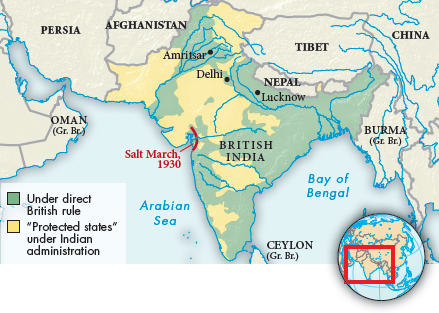Understanding World Societies:
Printed Page 898
Chapter Chronology
Gandhi’s Resistance Campaign in India
In 1915 Gandhi returned to India a hero. The masses hailed him as a mahatma, or “great soul” — a Hindu title of veneration for a man of great knowledge and humanity. In 1920 Gandhi launched a national campaign of nonviolent resistance to British rule. He urged his countrymen to boycott British goods, jobs, and honors and told peasants not to pay taxes.
The nationalist movement had previously touched only the tiny, prosperous, Western-educated elite. Now both the illiterate masses of village India and the educated classes heard Gandhi’s call for militant nonviolent resistance. It particularly appealed to the masses of Hindus who were not members of the warrior caste or the so-called military races and who were traditionally passive and nonviolent. The British had regarded ordinary Hindus as cowards. Gandhi told them that they could be courageous and even morally superior. Under Gandhi’s leadership, the Indian National Congress became a mass political party, welcoming members from every ethnic group and cooperating closely with the Muslim minority.
In 1922 some Indian resisters turned to violence, murdering twenty-two policemen. Savage riots broke out, and Gandhi abruptly called off his campaign. Arrested for fomenting rebellion, Gandhi served two years in prison. Upon his release Gandhi set up a commune, established a national newspaper, and set out to reform Indian society and improve the lot of the poor. For Gandhi moral improvement, social progress, and the national movement went hand in hand. Above all, Gandhi nurtured national identity and self-respect.
During Gandhi’s time in prison the Indian National Congress had splintered into various factions, and Gandhi spent the years after his release quietly trying to reunite the organization. In 1929 the radical nationalists, led by Jawaharlal Nehru (1889–1964), pushed through the National Congress a resolution calling for virtual independence within a year. The British stiffened in their resolve against Indian independence, and Indian radicals talked of a bloody showdown.

India, ca. 1930
Into this tense situation Gandhi masterfully reasserted his leadership, taking a hard line toward the British but insisting on nonviolent methods. He organized a massive resistance campaign against the tax on salt. From March 12 to April 6, 1930, Gandhi led fifty thousand people in a spectacular march to the sea, where he made salt in defiance of the law. A later demonstration at the British-run Dharasana salt works resulted in many of the 2,500 nonviolent marchers being beaten senseless by policemen in a brutal and well-publicized encounter. Over the next months the British arrested Gandhi and sixty thousand other protesters for making and distributing salt. But the protests continued, and in 1931 the frustrated and unnerved British released Gandhi from jail and sat down to negotiate with him over Indian self-rule. Negotiations resulted in a new constitution, the Government of India Act, in 1935, which greatly strengthened India’s parliamentary representative institutions and gave Indians some voice in the administration of British India.
Despite his best efforts, Gandhi failed to heal a widening split between Hindus and Muslims. Indian nationalism, based largely on Hindu symbols and customs, increasingly disturbed the Muslim minority. Tempers mounted, and both sides committed atrocities. By the late 1930s Muslim League leaders were calling for the creation of a Muslim nation in British India, a “Pakistan,” or “land of the pure.” As in Palestine, the rise of conflicting nationalisms in India based on religion would lead to tragedy (see “Independence in India, Pakistan, and Bangladesh” in Chapter 31).
Why did the British find it so difficult to suppress the Indian independence movement?
